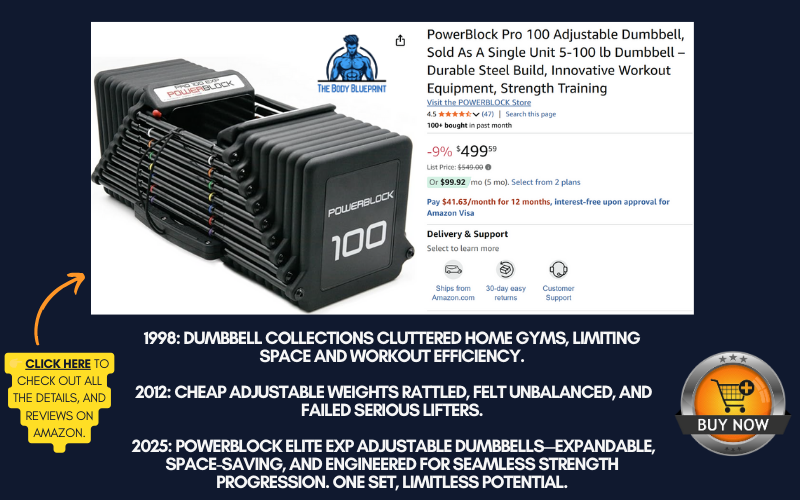You’ve seen them in ads—those chunky, geometric dumbbells that look like something ripped from a sci-fi weight room. PowerBlock Elite EXP Dumbbells promise to replace an entire rack of traditional weights. But here’s the unvarnished truth: they’re either a revelation or a regret, depending on who you ask. Let’s dissect this cult-favorite adjustable dumbbell system—no fluff, no sales pitch, just cold steel facts.
The Quick Verdict
For: Home lifters who need space-saving grit, hate clutter, and want expandable weights without mortgaging their garage.
Not For: Traditionalists who crave the heft of classic dumbbells, heavy lifters needing 90+ lbs, or anyone allergic to a slight learning curve.

The Problem They Solve (And Don’t)
Imagine a wall of dumbbells—28 pairs—devouring your floor space like a ravenous metal beast. PowerBlock Elite EXP compresses that chaos into a 20×12” footprint. That’s 95% less space. But here’s the rub: Adjustable dumbbells trade aesthetics for utility. These aren’t Instagram-friendly chrome trophies; they’re blunt tools for blunt-force progress.
Key Features: Brutal Honesty Edition
- Weight Range: Starts at 5-50 lbs (expandable to 70 or 90 lbs).
- Selector Pin: Swap weights faster than you can text “I’ll be late.”
- Durability: “Built like a tank” isn’t hyperbole—these survive drops, slams, and existential crises.
- Made in USA Option: For patriots and quality hawks (Elite USA model).
The Science of Adjustables
Adjustable dumbbells exploit progressive overload—the bedrock of muscle growth. But unlike fixed weights, you’re limited by the increments. PowerBlock’s 2.5-5 lb jumps work for most, but hypertrophy purists might crave finer control. As Eugene Thong, CSCS, notes: “They’re efficient, but not perfect. Think long-term adaptability over perfection.”
Realistic Results (No Fairy Tales)
- Year 1: You’ll build foundational strength. The 5-100 lb range covers curls, shoulder presses, rows.
- Year 2: Add the 70 lb kit. Now you’re deadlifting, lunging, pressing heavier.
- Year 5: Still clicking smoothly, no rattles. This is where they earn their keep.
But… If you’re chasing elite numbers (*e.g., 100+ lb dumbbell benches*), these tap out early.
PowerBlock vs. The World
| Feature | PowerBlock Elite EXP | Fixed Dumbbells | Nuobell |
|---|---|---|---|
| Space | 1 sq ft | 28 sq ft | 1.5 sq ft |
| Durability | Industrial-grade steel | Indestructible | Plastic components |
| Weight Changes | 5 seconds | Instant | 3 seconds (but fragile) |
| Cost | $399+ (expandable) | $2,000+ (full set) | $649 (prone to breaking) |
Charles Damiano, B.S. Clinical Nutrition, puts it bluntly: “PowerBlocks are the Toyota Tacoma of weights—ugly, unkillable, and absurdly practical.”
Who Should Avoid These?
- The Iron Aesthetician: If you need your gear to look like a Marvel prop, walk away.
- The Heavy Hitter: 90 lbs is solid, but seasoned lifters will hit ceilings.
- The Impatient: That selector pin takes 10 workouts to feel intuitive.
The PowerBlock Elite EXP Dumbbells aren’t magic. They’re a trade-off: space and savings for slight compromises in feel and max weight. For 80% of lifters, they’re a career-long investment. For the rest? A pricey paperweight.

Still skeptical? Let’s tackle the gritty questions nobody talks about—like why your gym partner might hate these, the one flaw even fanboys admit, and whether they’ll survive a rage quit mid-workout.
The steel rods stay tight if you maintain them—wipe sweat, avoid slamming. But yes, they’ll never be as silent as fixed dumbbells.
Technically yes, but the blocky design feels awkward. Stick to traditional lifts unless you’re okay with a learning curve.
Residential warranty covers defects, not gravity-induced regrets. Treat them like a toolbox, not a shot put.
The rectangular grips dig into palms during endurance work. Solution: chalk up, use gloves, or embrace the pain.
Only buy if you’ll outgrow 50 lbs. Pro tip: Track your PRs first—don’t let ego upsell you.
The blocky design fits most racks, but they’ll overhang. PowerBlock’s stand optimizes space—third-party racks work, but it’s like parking a Hummer in a compact spot.
The weight distribution is center-focused, so bicep curls feel neutral—but lateral raises? You’ll sense the blockiness. It’s a trade-off, not a dealbreaker.

YOUR NEXT STEPS:
